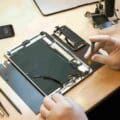Sometimes, things tip messily and often unexpectedly, just like a broken keyboard. Though the task can seem daunting, with some creative problem-solving and handy tips, you can replace your malfunctioning keyboard like a professional!
Where to start? That’s where we come in! Have no fear; the digital support crew at our blog is here to teach you exactly how to navigate through fixing your trusty clackerpad and hit back, plugging away in no time.
From picking out the perfect model for your laptop type and downloading the essential driver for installation, it doesn’t need to be intimidating! So grab a shallow pan of breathing techniques prepped for a new challenge— suits are optional. Read on for trusted methods crafted with care to help get you typing away quickly and efficiently!
Understanding Your Keyboard and its Components
Sometimes, the crucial pieces get overlooked, especially regarding computer setups. The keyboard can feel like a minuscule part of the big picture…until it stops functioning correctly.
But never fear! Having an understanding of its components can make replacing this vital instrument seamless.
Every keyboard has a Printed Circuit Board (PCB). This contains all the circuits and sensors for each key and can be seen without opening the keyboard case. Then you have keys (or keycaps) — these are the visible components that allow you to tackle typos, work through equations, and keep previously drafted documents safe from keyboard catastrophes.
Typically made from plastic and easily removable, these take the brunt of your activity. Lastly, a rubber dome or mechanical switch underneath each key helps set it back to its original position as you unpress it. Without these, the return action would likely feel cumbersome!
It’s now easier than ever to replace broken keyboards because you know the cause and components necessary for success. With this update, nothing will stand between your smooth typing prowess always!
Preparing for a Keyboard Replacement
Tired of your unresponsive keyboard? It sounds like it’s ready for retirement. Before you go out and purchase its replacement, here are a few things you should keep in mind.
Write down the features of your existing keyboard to find a better match for your specific needs. Is a number pad required? Brand preference? Making those decisions now will save time later.
What comes next? Deciding on what activities your new keyboard must perform. Beyond everyday tasks, will gaming be in the equation? That might change what model is best for you.
And finally, be prepared to dive in and do some installation. Removing the old one, putting in the new one…maybe even updating drivers or software before all is said and done! Preparing yourself now can make the process much easier later.
When that shiny new replacement arrives at your door, following these steps lets you make the most of it with minimal hassle.
Uninstalling the Old Keyboard and Installing the New One
Ready to upgrade that ancient keyboard? Uninstalling your old one may seem daunting, but no need to worry– it’s a task we can make as simple as a few clicks (or clips, instead).
Start by popping off the necessary attachments, then slowly disconnecting and detaching any cables connecting the two. Taking your time during this step ensures that you don’t unexpectedly unplug a vital component: facing certain death of electronics isn’t something we relish!
Once the old keyboard is safely packed away, it’s time to install the new one. Lucky for us, it follows suit with what once happened before, so just redo an older version of yourself! Popping, clicking and connecting like champagne corks, top it off with newly added screws or slots until completion.
After all is done and dusted – pun fully intended, try out pressing each key for size! You’ll be grateful you switched when your previously unresponsive or stuck keys become like dreams come true in typed form.
Troubleshooting Common Problems that Arise During Installation
If you’re considering replacing a broken keyboard, the process isn’t necessarily for the faint of heart! What if you run into common problems but don’t know how to fix them? Dare we say it — installation nightmare.
No worries — enlisting a repair expert in this operation is wise. They know all the ins and outs of installing keyboards, so compatibility issues or faulty connections won’t faze them. Plus, they can help troubleshoot any unexpected problems that may surface while upgrading your typing experience.
Just think: leave your keyboard woes to the backroom gurus, and your shiny new setup could be just around the corner. With the correct set of qualified hands on deck, getting back to work has never been easier!
Testing Your New Keyboard and Making Sure It Works Properly
It’s finally time – your new keyboard is here, eager to enter the fray! Before you make it your trusty typing companion, however, there are a few tests you should run.
That first one is for all those “normal” keys. Using a text editor or word processor, ensure each one is as responsive as expected by quickly whizzing through a few sentences.
Maybe it comes with some excellent multimedia capabilities? Beef your sound game by tweaking track volumes and muting audio like a pro using these bonkers buttons.
Test if the modifier keys – Shift, Alt, and Ctrl – also let you stay in control even during tumultuous document sessions.
Then, you can take the hassle out of using apps by ensuring function keys are savvy to your assignment requirements. With one last check and satisfactory scorecard, off on journal entries & more you go! Testing out your fresh new keyboard now will save much future frustration from key misadventures, so it’s worth the ten-minute plus!
Final Words
All in all, replacement keyboards are the best way to tackle pesky sticky keys and keycaps that have seen better days – and with these troubleshooting tips, you should have no trouble finding a solution! Remember to be patient while searching for a new keyboard because prematurely cracking open your laptop or desktop may likely cause more harm than good! So why risk trying to fix it alone when you can get some quality assistance? If you’re still having difficulty managing your replacement keyboard installation, don’t hesitate to call us. Our expert technicians will have the answers you need.









